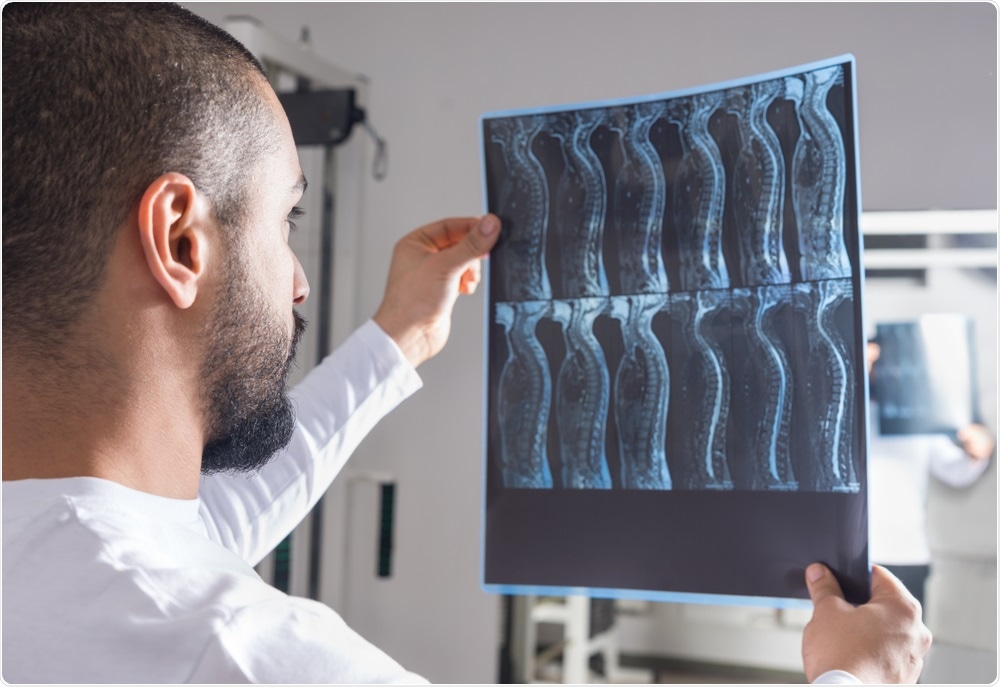Researchers used metagenomic sequencing to identify variations in virus and bacterial populations that occur following spinal cord injury in mice.

Spinal Cord Injury. Image Credit: Viacheslav Nikolaenko/Shutterstock.com
The novel metagenomic data sets described in mSystems, an open-access journal of the American Society for Microbiology, add to the understanding of the taxonomy and role of various microbes, like viruses.
This knowledge could help better predict how spinal cord injury-induced changes in the microbiome affect neurological and systemic consequences following traumatic spinal cord injury.
This is the first study that has applied metagenomics to characterize gut dysbiosis after spinal cord injury. A lot of people are interested in understanding the gut microbiome because of its potential impact on a host of comorbidities that affect people with spinal cord injury, including metabolic disease, cardiovascular dysfunction, decreased immune function, fatigue and mental health issues.”
Phillip Popovich, PhD, Professor and Chair, Department of Neuroscience, Ohio State University
Popovich is currently the Executive Director of the Ohio State University’s Belford Center for Spinal Cord Injury (OSU).
“There is a lot of literature in other fields that implicate the gut microbiome in the onset or progression of these comorbidities,” added Popovich.
We were able to show spinal cord injury dependent effects on a number of different bacteria and viruses – some increase, some decrease and some are virtually depleted by the injury. And because we used cutting-edge genome-resolved metagenomics and viromics, we were able to do more than determine how spinal cord injury affects the number and composition of gut bacteria. That is what gene targeting sequencing techniques like 16s rRNA sequencing are good at doing.”
Matthew Sullivan, PhD, Professor, Department of Microbiology, Ohio State University
Sullivan is also the Founding Director of OSU’s Center of Microbiome Science, as well as a co-senior author on the study.
“By comparison, metagenomic sequencing allows us to simultaneously evaluate how spinal cord injury affects bacteria, archaea, fungi, and viruses and then begin to predict the functional consequences associated with these changes in the microbial ecosystem of the gut,” added Sullivan.
While using metagenomics to research mammalian microbiomes is a recent approach, these approaches have long been used to understand microbial diversity in the oceans. In reality, Dr. Sullivan has been employing these strategies to assess the effect of viruses present in the ocean on global biogeochemistry.
In the current report, researchers conducted spinal cord injuries on the 10th thoracic spine (T10) or 4th thoracic spine (T4) in mice and compared their findings to those of sham injuries (i.e. spinal surgeries without spinal cord injury).
They gathered fecal samples at baseline and three weeks after injury (or surgery) and then conducted metagenomic tests on the samples. The researchers discovered that after spinal cord injury, the huge quantity of some beneficial bacteria reduced while the relative abundance of potentially pathogenic bacteria increased.
They also discovered that after spinal cord injury, microbial genes encoding proteins for vitamin B6, folate, and tryptophan biosynthesis, all of which are important pathways for central nervous system activity, were reduced functionally. After spinal cord injury, viruses from beneficial bacterial hosts reduced when viruses from pathogenic bacterial hosts rose.
Spinal cord injuries occur at different spinal cord levels, and the level at which an injury occurs will have distinct effects on the gut and the microbiome.”
Phillip Popovich, PhD, Professor and Chair, Department of Neuroscience, Ohio State University
Indeed, the researchers discovered that while all mice with spinal cord injuries had altered viromes and microbiomes, some of these modifications were significantly increased in mice with higher levels of spinal injury.
Even though this is a pilot project and has not yet been tested on humans, the results include the initial steps in improving treatments and therapies.
Lactobacillus johnsonii, for instance, which was reduced in mice after spinal cord injury, was a key source of lactocepin, an anti-inflammatory bacterial protease needed for proper immune function.
Thus, replacing Lactobacillus johnsonii with custom-made probiotics may aid in boosting immune responses and reversing the infectious problems that plague people with spinal cord injuries.
Source:
Journal reference:
Du, J., et al. (2021) Spinal Cord Injury Changes the Structure and Functional Potential of Gut Bacterial and Viral Communities. mSystems. doi.org/10.1128/mSystems.01356-20.